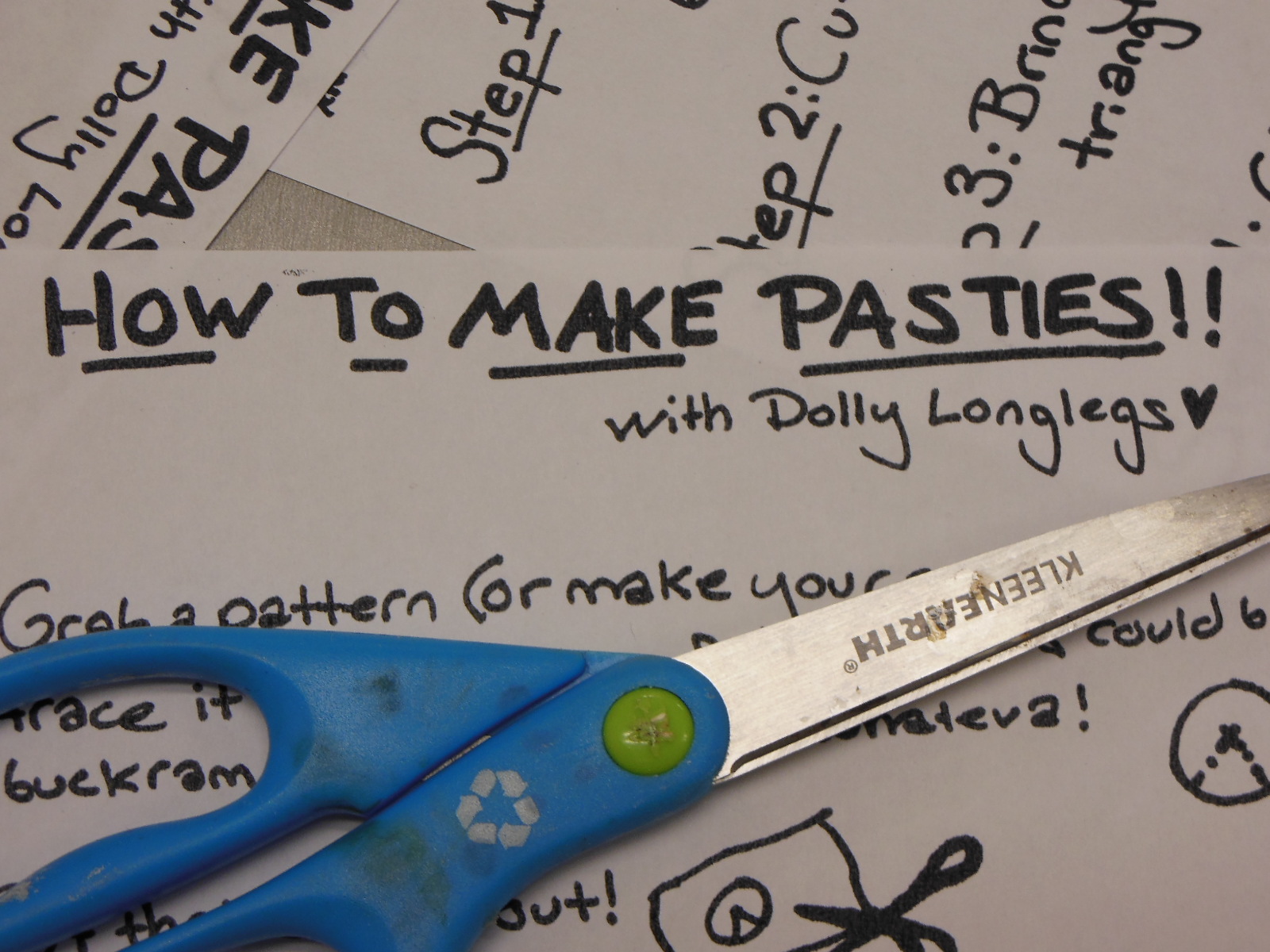MICA ‘Workin’ the Tease’ offers a taste of burlesque with the pros
A reporter can learn a lot about the changing face of a college campus simply by spending a few hours in the school library. A quick glance, for example, at the 1964 MICA student handbook reveals that the curriculum included courses in Working with Clay, Fashion Arts and Interior Design. Yearbooks from that era feature such Milquetoast activities as the Student Council, Dance Committee, Drama Club, Spring Formal and the Arts Ball. There are no listings, however, for workshops on “How to Look Seductive”; nor did Fashion Arts offer tips on “How to Make Pasties.”
A lot has changed in the last fifty years, particularly in the area of sexuality; and ironically, a sex-centric art form which was fading away in 1964 is the focus of this year’s MICA Exhibition Development Seminar (EDS).

Workin’ the Tease: The Art of Burlesque in Baltimore is the theme of this year’s EDS. The group’s year-long endeavor will culminate later this month with an exhibit and a live show at the Lyric Opera House. Last Friday evening, about 20 people gathered at MICA’s Wellness Center to participate in an EDS-sponsored workshop on burlesque basics. The workshop, “A Taste of Burlesque with the Pros,” was free and open to the public.
The pros for this class included Kay Sera and Doctor Ginger Snapz, two of the most popular performers on the burlesque scene today; and Dolly Longlegs, a 2010 graduate of MICA and one of burlesque’s rising young stars.
The class was a mix of MICA students, committed performers and curious novices. Excluding the instructors, five said they had experience in burlesque, three said they had some experience, while seven said they had no experience at all. Local performers Ruby Spruce was also on hand; not to teach but to listen and learn. Another performer in attendance was Lady D, a MICA student and member of the on-campus troupe, The Galhaus Review.
Seated in a circle in the yoga room, Kay started the first session, “A History of Burlesque,” by asking the participants what came to their mind when they heard the term burlesque? The answers included “confidence, crazy, performance, glitter and stripping”. Kay said, “Those are all true, but as you learn about burlesque, you’ll find there is even more.”
Starting with the 19th century, Kay offered a fascinating, fast-moving sweep of burlesque history.
Unlike Vaudeville, Kay explained, burlesque offered performers a degree of security in that they didn’t have to search for accepting venues. Long before T.V. and radio, burlesque had built a steady and appreciative following. In New York, crowds went nuts for stripping at Minsky’s, while here in Baltimore, there was The Block.
Kay focused briefly on some of the more famous female burlesque performers of the past; luminaries such as Little Egypt, Millie DeLeon, Sally Rand, Josephine Baker and Gypsy Rose Lee; Ann Corio, Lilli St. Cyr, Jennie Lee and Blaze Starr. She also talked about the scandals which surrounded several of the performers: the infamous night they raided Minsky’s; Mae West’s obscenity trial.
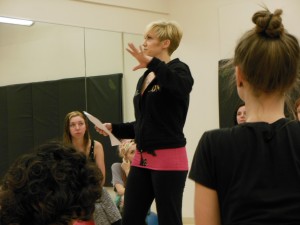
There was also a short discussion about Blacks and Asians in the world of burlesque. In segregated America, African-Americans had the Black Currants and the Chitlin’ Circuit. Asians could look to a San Francisco venue called Forbidden City USA.
Post-war America witnessed the decline and stigmatization of burlesque. By the 1970’s and 80’s, Kay noted, “burlesque was undergoing a necessary pruning. Neo-burlesque offered something new with roots.”
Kay purposely omitted including any mention of burlesque’s many famous male performers (W.C. Fields, Abbot and Costello, Milton Berle and Red Skelton all come to mind), citing the time constraints and the focus of the workshop. She did, however, encourage the students to read the performers’ biographies; and to go to YouTube and look for the video of Sally Rand at the Chicago World’s Fair. And she urged the class to make it a point to see the current crop of Neo-burlesque performers.
“Get out and see the shows for yourself. There is a lot going on. Angie Pontani is an international star, and she comes to Baltimore 2-3 times a year. Go see her. And see Trixie Little and The Evil Hate Monkey. They were the driving force behind the resurgence of burlesque in Baltimore ten years ago. They are the reason we have such an active scene here today.”
***********************
After absorbing Kay’s chronicle, the class moved to a small studio for a lesson by Dolly Longlegs in how to make pasties.
Dolly, who is in her 4th year of performing burlesque in the Baltimore area, was a founding member of The Galhaus Review. Other members of that first troupe include Marla Meringue, Dixie DeVamp and Heavens to Betsy.
Dolly laughingly recalled her first attempt at pastie-making with her Galhaus cohorts. “We were drinking wine and trying to figure it out together. This may be the first time I have taught this skill.” She added, “I used to work in an art center teaching children. It’s funny to be teaching this class tonight.”
Dolly told the class, “Pastie making is an exercise in self-awareness. Only you know the size of your nipples.”
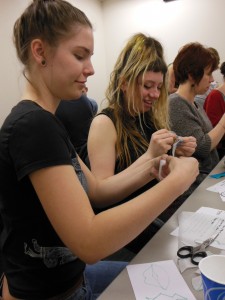
With sharpies in hand, the participants traced patterns onto pieces of backing material. Once the patterns were cut, they began the delicate job of assembling their pasties. Some had chosen heart shapes; others opted for the more traditional round design. One woman hoped that her bacon-shaped pasties would really sizzle.
Dolly gave the students advice on such things as procuring the best kinds of base and finish materials; pattern making and cutting; working with sequins and rhinestones; even what type of glue to use.
“You can glue most anything together with E6000,” opined the experienced ecdysiast.
Dolly also demonstrated how, by using common brass fishing lure leads, one could easily attach a pair of spinning tassels.
Needless to say, this reporter will never look at fishing tackle the same way again.
Area residents Faith Sentz and Aurelia Sophie compared notes while stitching their pasties together. The two became friends while attending an Expose pole dancing class. I asked what attracted them to the burlesque workshop?
Faith said she looked at pole dancing for fitness and as a hobby but admitted, “I’ve always wanted to do burlesque. It’s just finding the time to do it.”
Aurelia started pole dancing after spending years learning karate, saying she simply wanted something to do which didn’t require “kicking a lot of men around.”
“I tried tap dancing, too, but that wasn’t for me,” she said. For Aurelia, getting into burlesque is a chance to try something new.
Across the table from Aurelia and Faith, two EDS students, Taylor and Bree, were also busy with needles in hand. Behind them sat Alex, the lone EDS guy in Friday’s workshop.
The EDS students are broken down into four different groups: Education, Design, Management and Communication. But there has been a lot of cross-pollination in this course. Taylor said, “To learn about burlesque, we had to totally immerse ourselves in this class.” Bree quickly agreed and added, “We’ve discovered a lot about the scene. There is so much going on here in Station North alone.”
Alex seemed to find the whole pastie-making exercise highly amusing. Meanwhile, Taylor and Bree paused for a moment to consider their tailoring efforts. Bree quizzically confided, “I don’t know if these are the right size for me. This is really something you need to do topless.”
***********************
Moving back to the yoga room, Kay shared her expertise in the area of character development.
Speaking on transformation and motivation, Kay said, “Before you step onto the stage make sure you know what you are doing and why you are doing it. Are you playing an archetype? A mermaid? Are you going from old to young? Nice to nasty? Why are you doing what you’re doing? What is your motivation?”
On connection and communication, one of the moves Kay (and later Ginger) stressed was a performer’s gaze.
“If you choose to perform, get comfortable with that gaze. Make eye contact with the front, the middle and the back of the room. It’s part of what engages an audience.”
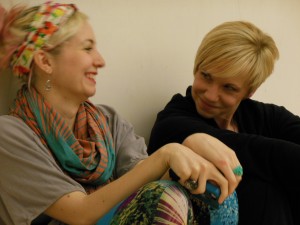
Other areas in Kay’s presentation were:
Costuming ~ “Layers are part of the tease. As Trixie Little says, ‘More is more.’ Burlesque is not just a bra and panties. That may be OK for the bedroom but not for a performance. The audience has paid to see you. You owe them something sparkly.”
Choreography ~ “Dancers: Don’t get too wrapped up in your count. Non-dancers: Hit key marks and moments.”
Music ~ “Avoid lyrical literalism. You music cannot tell your story, so don’t let the song tell your story. YOU tell the story.”
Tying these three areas together, Kay said, “Your body and your movements are your voice. Once you get the movements down, always rehearse in what you’re going to be wearing onstage. If you’re stripping off stockings and plan to wear Brand A, don’t rehearse in Brand C. Brand C may be less expensive but not have the same elastic qualities as Brand A. You don’t want to find yourself on stage fighting to remove something that seemed so easy in rehearsal.”
Kay also offered the class perhaps the most cogent advice of the night:
“If you screw up on stage – move on. Otherwise, you break character. Besides, you’re probably the only person in the theater who will know you messed up.”
***********************
Building on several of Kay’s points, Doctor Ginger Snapz took the class through a series of exercises designed to put theory into practice. One exercise focused on enticing looks. Pairing students together, Ginger asked the students to face their partner and turn on the sex appeal. For some, a smile was seductive enough. For others, it was a subtle move: a shake of the hair or a touch of the lips. One student said, “My partner closed his hoodie. I totally did not expect that to happen.”
Lady D was paired with Alisa G, a freshman who is part of Galhaus Review. Alisa said she learned about Galhaus through a friend in the campus Rocky Horror Picture Show club. “I’ve always been inspired by burlesque performers and was fascinated by the pin-up culture.”
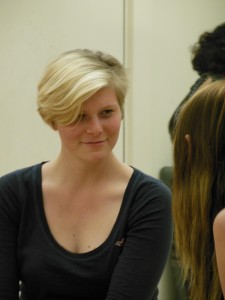
Finishing the looks exercise, Ginger led the class in several dance and movement drills. These included pointers on the shoulder shimmy, hand and arm movements, entrances and extis and, of course, the indispensable bumps and grinds.
“Bumps are dirty,” Ginger rightly observed. “Grinds are basically just rotating around one point.”
Putting it all into practice, Ginger asked the class to think about making an entrance; welcoming an audience with a swoop of an arm or introducing a particular body part, such as a leg. The class then gave it a whirl to a 30-second snippet from the well-known number, “Hey, Big Spender”.
There was plenty of howling as the entrances ran the gamut from coy crossings to something akin to the opening of the Richard Simmons show.
Ginger then asked the students, “What were you saying with your body when you walked on stage?”
Lady D explained the motivation behind her entrance, disclosing, “With my hands on my hips, I am signaling that I’m in charge here.”
Another participant said, “I tend to be more reserved in my entrances, so I wanted to try something more dramatic.”
Seduction, control and drama are all part of the allure of burlesque, but for Ginger, it all boils down to one word. S-E-X.
“Political jabs, humorous turns or classic stripping – it’s always about sex. To be a successful performer, you have to figure out what YOUR sexy is.”
On that note, the eager young hopefuls started packing up for the night.
Lady D paused briefly to tell this reporter, “It is awesome to know that others are just as interested in burlesque. I did the summer program here. That’s where I learned about the Galhaus Revue.” D added “I started dancing when I was four but never did anything quite like this!”
***********************
A lot has changed at MICA – and in the world as a whole – since the middle of the 20th Century, particularly when it comes to attitudes toward sex.
Or has it?
A one-liner from the 1927 MICA yearbook may have summed up this age-old dilemma the best:
“A girl does not want a chaperone, she wants a chap alone.”
(Many thanks to Kathy Cowan for access to the MICA Archives, Decker Library, Maryland Institute College of Art)

Anthony C. Hayes is an actor, author, raconteur, rapscallion and bon vivant. A one-time newsboy for the Evening Sun and professional presence at the Washington Herald, Tony’s poetry, photography, humor, and prose have also been featured in Smile, Hon, You’re in Baltimore!, Destination Maryland, Magic Octopus Magazine, Los Angeles Post-Examiner, Voice of Baltimore, SmartCEO, Alvarez Fiction, and Tales of Blood and Roses. If you notice that his work has been purloined, please let him know. As the Good Book says, “Thou shalt not steal.”

